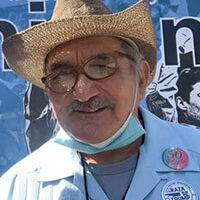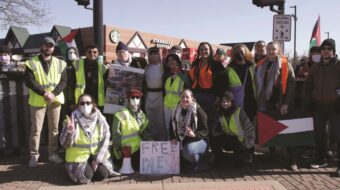Thirty-five years ago, on Aug. 29, 1970, some 25,000-30,000 people, mostly Mexican Americans, marched through the heart of the East Los Angeles barrios protesting the war in Vietnam. It was the largest Mexican American political demonstration ever until Cesar Chavez’s funeral in 1993. It was a time when young working-class Chicanos and Latinos were beginning to refuse to go to Vietnam, and those on the front lines, along with African American and white soldiers, began to resist the Pentagon’s orders.
La Raza did its part in bringing an end to that war.
It was a grassroots, community-based effort that drew from the working-class barrios across the country: from San Diego to Chicago’s Pilsen community, Seattle, San Antonio, Denver, El Paso’s Segundo barrio. Puerto Rican Young Lords from New York raised the Puerto Rican flag over the East L.A. park where people gathered that 1970 summer day.
New Mexico Hispanos with over 10 generations on the land were there, as well as undocumented immigrants who had recently crossed over at Tijuana. Lots of grandmothers, mamas and children sat on the grass with veterans of World War II, Korea, Vietnam and lesser-known “excursions” into Latin America and Laos.
The demonstration was broken up by the police. In the upheaval that followed, three Chicanos were killed, including the foremost Mexican American journalist Ruben Salazar. The police and press said Salazar’s killing was accidental, and called the upheaval a riot by the protesters. The people called it a police riot and said the shooting of Salazar was no accident. Earlier in the year government forces had shot down protesting students at Kent State and Jackson State.
The mass peace demonstrations were not as large after such attacks, but the movement continued. A few years later the draft closed down, Nixon was impeached, and the war was ended. The “Vietnam syndrome” set in — the American public was no longer willing to tolerate wars with sizable losses of U.S. lives.
After a generation passed, the “masters of war” began testing the durability of the Vietnam syndrome. They used the 9/11 attack, unprecedented lies, and promises of a “smart” war with minimal losses to win some support for the attack on Iraq in 2003. The quagmire of the occupation, however, with its human and monetary losses, has brought back the Vietnam syndrome.
It’s a 21st century syndrome now. The people’s movements have gotten “smart” too, with listservs, blogs and e-mail blasts. It’s a globalized peace movement, and lies have no place to hide for long. The basis of the syndrome is the same, however: majority antiwar sentiment at the grass roots. The peace train is passing through middle America. People are getting on at Main Street and at Martin Luther King and Cesar Chavez boulevards.
On Aug. 16, they got on board at 1,600 peace vigils across the nation in solidarity with Cindy Sheehan. The grass roots want our troops out of Iraq ASAP.
Now the task is to go into the neighborhoods, the suburbs and inner cities, to factories, office buildings and farmlands, and mobilize the growing majority peace sentiment into meaningful political action. For middle-aged boomers like me it is an opportunity to build on and move forward from the great peace movements of our youth. Today the peace movement cannot be marginalized. It’s too mainstream. It’s what’s going on.
Some of us peace activists of the Chicano Moratorium era are coming together with other Latino activists we have come to know around the country and with the newer generations and immigrants. We call ourselves Latinos For Peace. We have launched an open letter/petition drive. We started with e-mails among friends. Now, names are coming in from all across the country.
Hilda Reyes Jensen, a 16-year-old Brown Beret who helped organize the first Chicano Moratorium against the Vietnam War in 1969, has sent in the names of six Latinos in Alabama. Sijisfredo Aviles, a Puerto Rican draft resister in the ’60s, is sending in names from Chicago. Ernesto Vigil of Denver, one of the first Chicano draft resisters in 1967, is getting together names in Colorado. Elizabeth Betita Martinez, who wrote antiwar stories in the New Mexico Chicano newspaper El Grito del Norte in the ’60s, is getting together people in the San Francisco Bay Area. Jorge Mariscal, a Vietnam veteran turned University of California at San Diego Latino studies professor and counter-recruitment activist, is getting faculty and students on board.
Margarita Alvarez, a Guatemalan immigrant rights and peace activist from Garland, Texas, has signed on. She plans to go to the Sept. 24 antiwar demonstration in Washington, D.C. We want to have some 10,000 Latino names on our open letter for her and others to present to the Hispanic Congressional Caucus and other representatives.
It’s an ambitious plan, but we are inspired by Cindy Sheehan, Maxine Waters, our own Fernando Suarez de Solar and so many others. We know that together we all can help Bring Our Troops Home!
Check out our web site, . Si se puede!
Rosalío Muñoz (rosalio_munoz @ sbcglobal.net) was chair of the Aug. 29, 1970, National Chicano Moratorium. He is a co-founder of Latinos for Peace.

MOST POPULAR TODAY

High Court essentially bans demonstrations, freedom of assembly in Deep South

Zionist organizations leading campaign to stop ceasefire resolutions in D.C. area

UN warns that Israel is still blocking humanitarian aid to Gaza


U.S. imperialism’s ‘ironclad’ support for Israel increases fascist danger at home






Comments